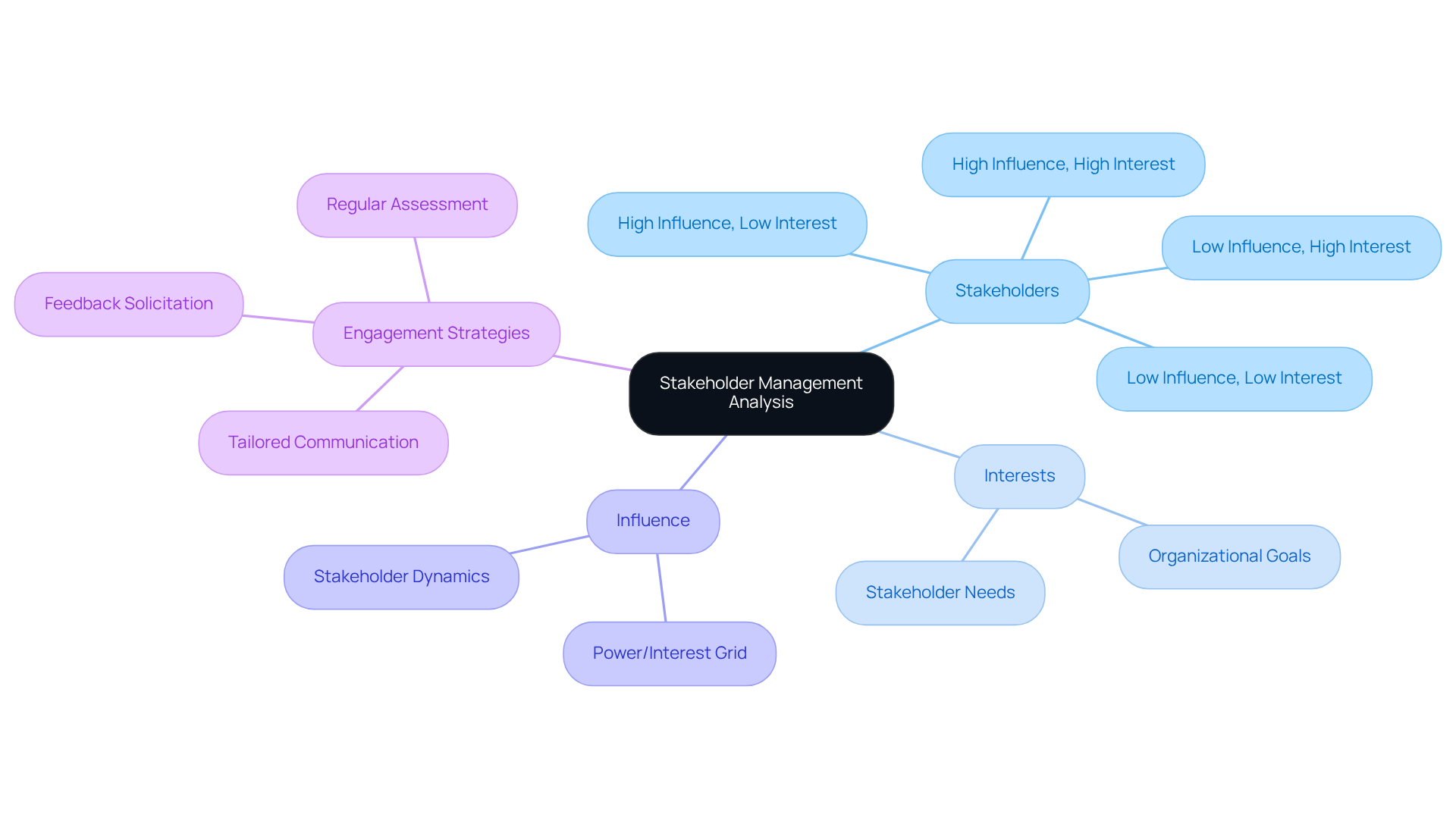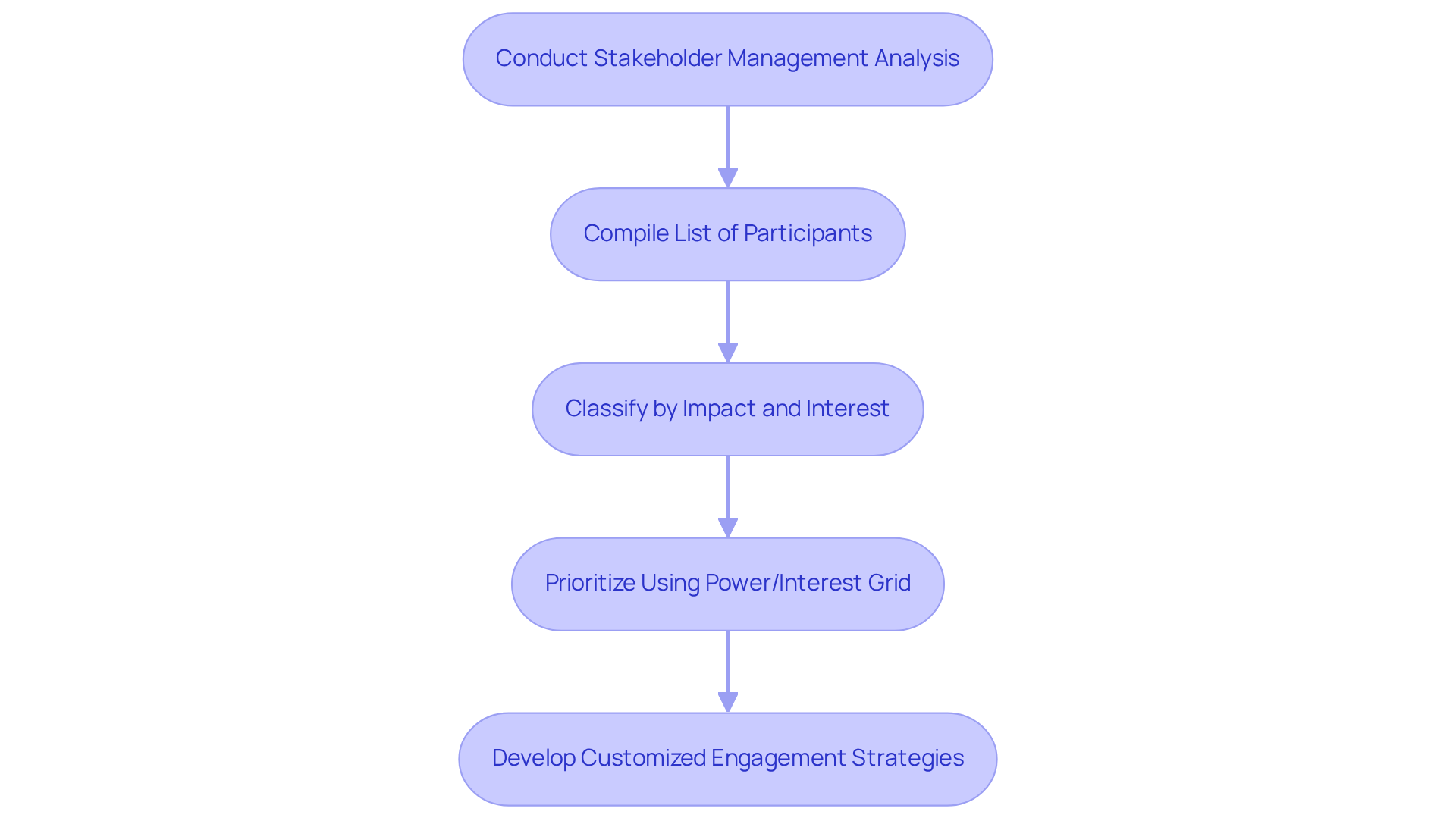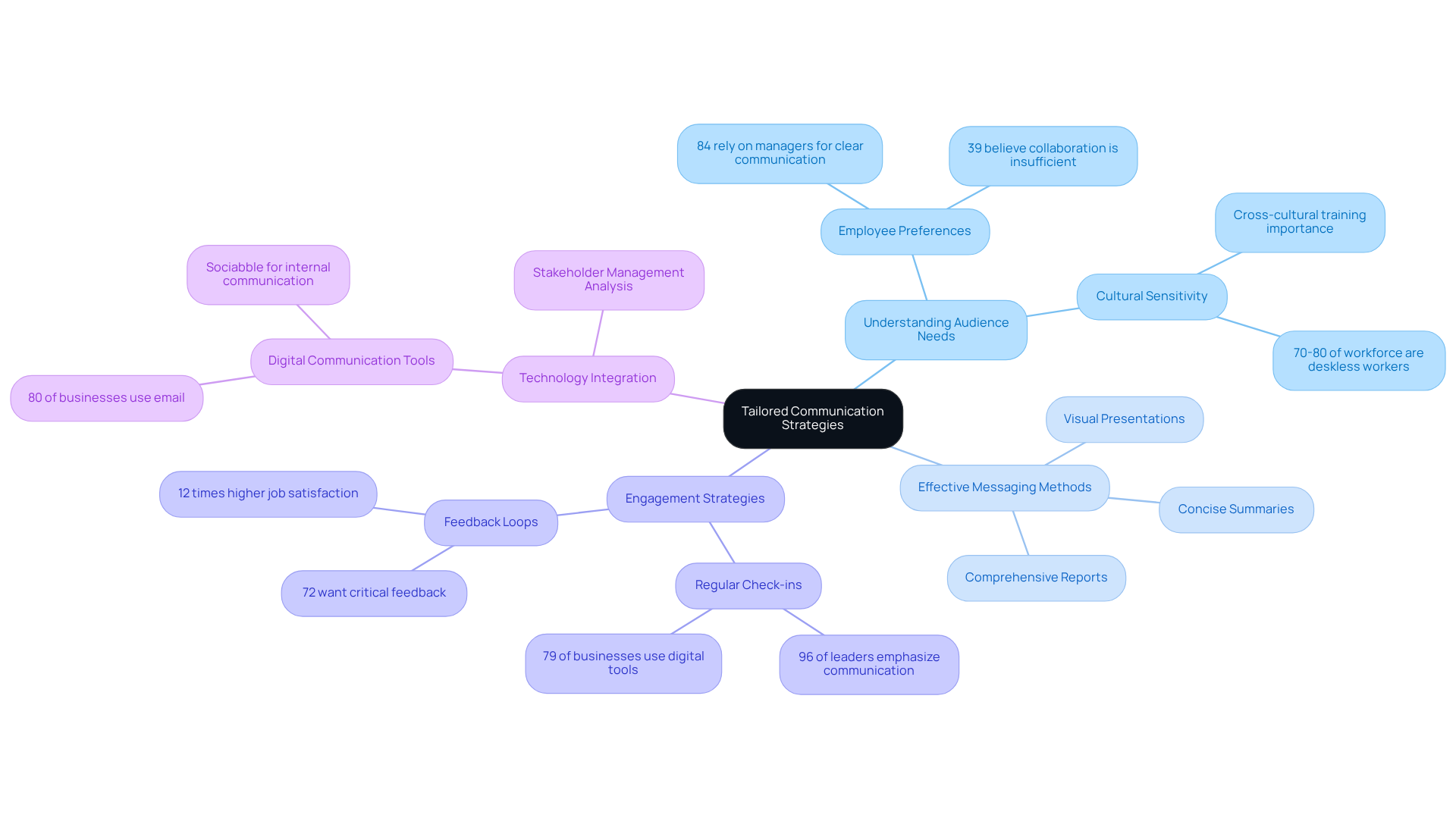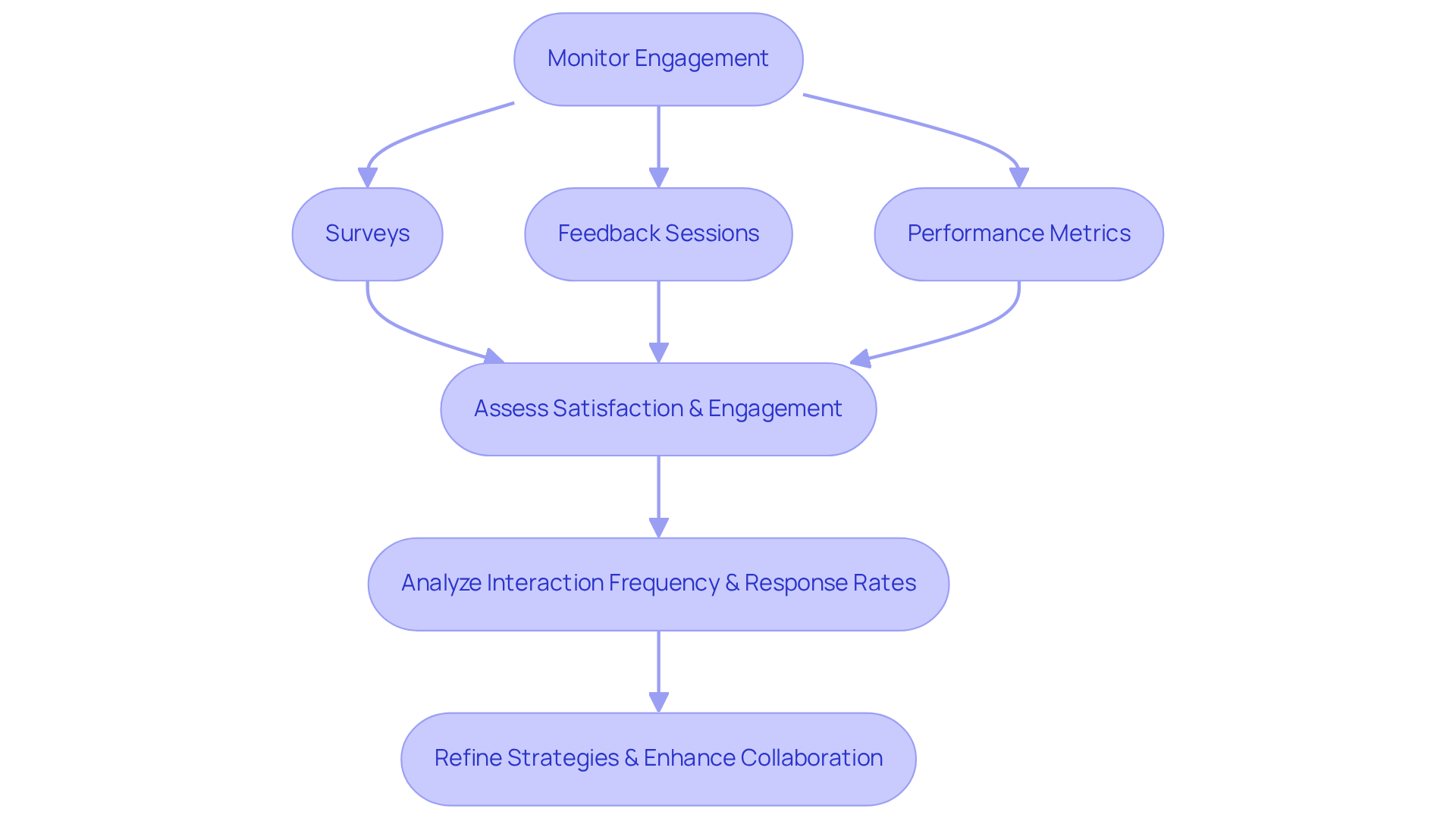Overview
The article delineates four pivotal practices for effective stakeholder management analysis:
- Identifying and prioritizing key stakeholders
- Developing tailored communication strategies
- Monitoring and evaluating engagement
These practices are indispensable, as they empower organizations to engage critical stakeholders effectively, culminating in enhanced project outcomes and elevated success rates. Statistics reveal that active stakeholder involvement significantly boosts the likelihood of achieving major objectives, underscoring the necessity of these practices.
Introduction
Navigating the complexities of stakeholder management is essential for any organization aiming to achieve its goals. By understanding and prioritizing the interests and influences of various stakeholders, companies can tailor their engagement strategies to foster meaningful relationships and drive project success. However, with so many competing interests and potential pitfalls, how can organizations ensure they are effectively managing these critical connections? This article delves into four key practices that not only enhance stakeholder management analysis but also empower organizations to thrive in an increasingly interconnected landscape.
Understand Stakeholder Management Analysis
Identifying and understanding the individuals or groups that can influence or are impacted by an initiative is crucial for stakeholder management analysis. This process entails evaluating their interests, influence, and potential effects on outcomes. A comprehensive analysis of stakeholders allows organizations to prioritize engagement efforts, focusing on the most critical participants. This fundamental understanding is essential for stakeholder management analysis, as it aids in developing effective communication strategies and fostering positive relationships, which are vital for achieving success.
For example, employing tools such as the Power/Interest Grid enables organizations to categorize stakeholders based on their level of influence and interest, thereby guiding tailored engagement strategies. Studies indicate that initiatives with clearly defined stakeholder strategies succeed 83% of the time, compared to only 32% for those lacking such strategies. This underscores the importance of stakeholder management analysis in shaping outcomes and ensuring alignment with organizational goals.
Moreover, firms that actively engage with stakeholders are 50% more likely to meet their significant objectives, highlighting the critical role of involvement in overall success. Incorporating insights from case studies, such as 'Influence Impact: Evaluating Stakeholder Power and Interest,' can further demonstrate the practical application of these concepts in real-world scenarios.

Identify and Prioritize Key Stakeholders
To effectively manage interested parties, organizations must first conduct a stakeholder management analysis to identify their key participants. This entails compiling an extensive list of all possible participants and classifying them according to their impact and interest in the project. Once recognized, parties involved should be prioritized using frameworks such as the Power/Interest Grid, which aids in determining which individuals require more engagement and communication. For instance, parties with significant influence and strong interest should be closely managed and kept informed, while those with minimal influence and low interest may need less frequent updates. This strategic prioritization, informed by stakeholder management analysis, ensures that resources are allocated efficiently, maximizing the potential for success in the initiative.
Current trends suggest that organizations are increasingly acknowledging the importance of customized engagement strategies, ensuring that various participant voices are heard and taken into account throughout the project lifecycle. Companies that actively involve interested parties are 50% more likely to achieve their major goals, highlighting the importance of stakeholder management analysis in effectively managing these individuals. Furthermore, the average Net Promoter Score (NPS) for engaged parties is 75, emphasizing the positive effect of strong relationships on organizational satisfaction.

Develop Tailored Communication Strategies
Developing customized messaging strategies requires a deep understanding of the unique needs and preferences of each interest group. This entails recognizing the most effective methods for conveying information, determining the frequency of updates, and selecting the appropriate type of information to share. For example, while some participants may favor comprehensive reports, others might find concise summaries or visual presentations more beneficial. Establishing clear objectives and expectations is essential for enhancing participant engagement. Regular check-ins and feedback loops not only ensure stakeholders feel valued but also significantly improve project outcomes.
Statistics indicate that organizations with successful interaction strategies are 3.5 times more likely to achieve better results, and companies with engaged employees experience up to 4.5 times more revenue growth than those without. Furthermore, workers who encounter clear business interactions report 12 times greater job satisfaction compared to those accustomed to ineffective workplace dialogue. Leveraging technology, such as stakeholder management analysis, can bolster information-sharing efforts, ensuring all parties remain informed and engaged. Notably, 79% of enterprises utilize digital messaging tools, underscoring technology's critical role in enhancing interaction strategies.
Moreover, it is imperative to recognize that miscommunication costs U.S. companies an estimated $1.2 trillion annually, highlighting the financial repercussions of inefficient dialogue. Integrating these elements into interaction strategies can lead to more effective participant involvement.

Monitor and Evaluate Stakeholder Engagement
Monitoring and assessing participant involvement is crucial for ensuring effective communication strategies and fostering robust relationships. Organizations can leverage:
- Surveys
- Feedback sessions
- Performance metrics
to evaluate participant satisfaction and engagement. By setting clear goals for participant involvement, organizations can assess success and identify areas for improvement. For example, tracking the frequency of interactions and analyzing response rates can provide valuable insights into the effectiveness of communication.
Moreover, routine evaluations indicate that initiatives with highly engaged participants are 78% more likely to succeed, compared to just 40% with minimal involvement. Consequently, by continuously refining engagement strategies through stakeholder management analysis, organizations can adapt their approaches to better align with stakeholder needs, ultimately enhancing collaboration and driving project success.

Conclusion
Understanding and implementing effective stakeholder management analysis is essential for the success of any initiative. Recognizing the importance of:
- Identifying key stakeholders
- Prioritizing their involvement
- Developing tailored communication strategies
- Continuously monitoring engagement
significantly enhances an organization's chances of achieving desired outcomes.
This article emphasizes that thorough stakeholder analysis enables organizations to focus their efforts on the most influential parties, ensuring that communication is both strategic and effective. Utilizing frameworks like the Power/Interest Grid allows for a structured approach to stakeholder engagement. Moreover, customized messaging and regular evaluations foster strong relationships that are crucial for project success.
Ultimately, the significance of stakeholder management cannot be overstated. Organizations that actively engage their stakeholders not only improve their chances of meeting objectives but also cultivate a collaborative environment that drives innovation and growth. By adopting these best practices and prioritizing stakeholder relationships, organizations position themselves for sustained success in an increasingly interconnected landscape.
Frequently Asked Questions
What is stakeholder management analysis?
Stakeholder management analysis involves identifying and understanding individuals or groups that can influence or are impacted by an initiative. It evaluates their interests, influence, and potential effects on outcomes, allowing organizations to prioritize engagement efforts.
Why is understanding stakeholders important?
Understanding stakeholders is crucial for developing effective communication strategies and fostering positive relationships, which are essential for achieving success in initiatives.
What tools can be used for stakeholder analysis?
Tools such as the Power/Interest Grid can be employed to categorize stakeholders based on their level of influence and interest, guiding tailored engagement strategies.
What impact do defined stakeholder strategies have on initiative success?
Initiatives with clearly defined stakeholder strategies succeed 83% of the time, compared to only 32% for those without such strategies, highlighting the importance of stakeholder management analysis.
How does active stakeholder engagement affect organizational objectives?
Firms that actively engage with stakeholders are 50% more likely to meet their significant objectives, emphasizing the critical role of involvement in overall success.
Can you provide an example of practical application of stakeholder management analysis?
Insights from case studies, such as 'Influence Impact: Evaluating Stakeholder Power and Interest,' demonstrate the practical application of stakeholder management analysis concepts in real-world scenarios.




